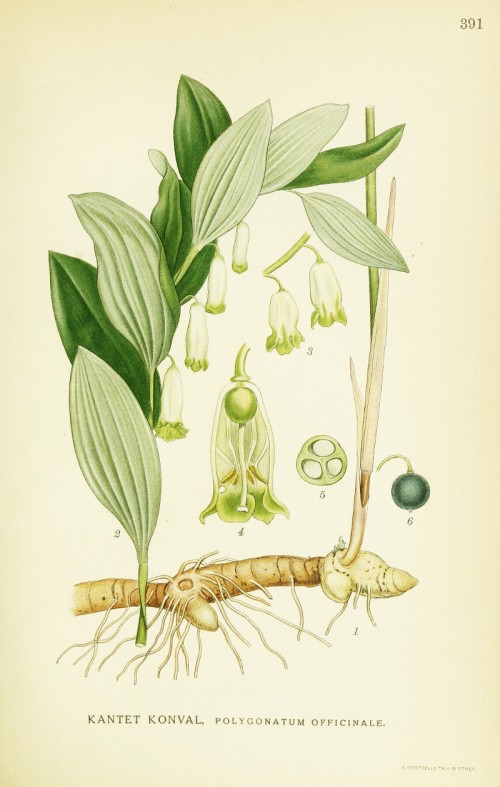Polygonatum odoratum (Mill.) Druce - syn.Polygonatum japonicum C. Morren & Decne.; Polygonatum officinale All.; Convallaria polygonatum L. - Asparagaceae (Liliaceae)
aromatic Solomon's-seal, 玉竹 yu zhu (chin.), Salomonssiegel, Duftende Weißwurz
Perennial rhizomatous herb, up to 50cm high, native to Europe and northern Asia; leaves elliptic to ovate-oblong, abaxially glaucous, inflorescences 1-2 flowered, flowers pendulous, yellowish green to white; berries blue-black, 7-10mm.
http://www.efloras.org/florataxon.aspx?flora_id=2&taxon_id=200027862
„The root of Polygonatum odoratum (YuZhu), also a medicinal food has long been used for the treatment of diabetes… The n-buthanol fraction, a saponin-rich fraction obtained by partitioning the ethanol extract with n-buthanol after petroleum ether and acetic ether showed the highest anti-diabetic potential in glucose uptake in HepG2 cells followed by acetic ether fraction which was rich in flavonoids. Further fractionation the saponin-rich fraction using macroporous resin column (D101), polysaccharide, flavonoid and saponin rich fractions were obtained by elution with water, 40% and 60% ethanol, respectively and their anti-diabetic potentials proved by glucose uptake test in HepG2 cells and STZ-induced diabetic rats were in the order of saponin rich fraction > flavonoid rich fraction > polysaccharide rich fraction. Long-term therapy test (60 d) in severe diabetic rats indicated that saponin-rich fraction significantly ameliorated clinical symptoms of diabetes including the elevated blood glucose, body weight loss as well as the increased food and water intake while flavonoid-rich fraction was more potential than saponin-rich fraction to increase superoxide dismutase (SOD) activity and decrease malondialdehyde (MDA) level in rat plasma. Additionally, saponin-rich fraction and flavonoid-rich fraction showed α-glycosidase inhibitory activity with IC50 value of 2.05 ± 0.32 and 3.92 ± 0.65 mg/ml, respectively.“
[Saponin rich fractions from Polygonatum odoratum (Mill.) Druce with more potential hypoglycemic effects., Deng, Y., He, K., Ye, X., Chen, X., Huang, J., Li, X., Li, P., Journal of ethnopharmacology, Vol.141(1), 2012, 228-233]
http://www.sciencedirect.com/science/article/pii/S0378874112001055
„Azetidine-2-carboxylic acid (ACA) in P. rhizomes is a potent toxin that could be incorporated into proteins in place of proline leading to protein dysfunction… The content of ACA in P. sibiricum (5.39 ± 1.67 mg/g, N = 29, mean ± standard deviation) was significantly lower than that in P. odoratum (9.23 ± 3.67 mg/g, N = 20).“
[Gas chromatographic determination of azetidine-2-carboxylic acid in rhizomes of Polygonatum sibiricum and Polygonatum odoratum., Baek, S.H., Lee, J.G., Park, S.Y., Piao, X.L., Kim, H.Y., Bae, O.N., Park, J. H., Journal of Food Composition and Analysis, Vol.25(2), 2012, 137-141]
„Polygonatum odoratum lectin could simultaneously induce apoptosis and autophagy in human non-small cell lung cancer A549 cells. POL initiated apoptosis through inhibiting Akt-NF-κB pathway, while POL triggered autophagy via suppressing Akt-mTOR pathway, suggesting the molecular switch role of Akt in regulating between POL-induced apoptosis and autophagy.“
[Molecular Switch Role of Akt in Polygonatum odoratum Lectin-Induced Apoptosis and Autophagy in Human Non-Small Cell Lung Cancer A549 Cells., Li, C., Chen, J., Lu, B., Shi, Z., Wang, H., Zhang, B., Wang, Y., PloS one, Vol.9(7), 2014, e101526]
http://journals.plos.org/plosone/article?id=10.1371/journal.pone.0101526

Lindman, C.A.M., Bilder ur Nordens Flora, vol.2, t.391 (1922-1926)
http://plantgenera.org/species.php?id_species=821792